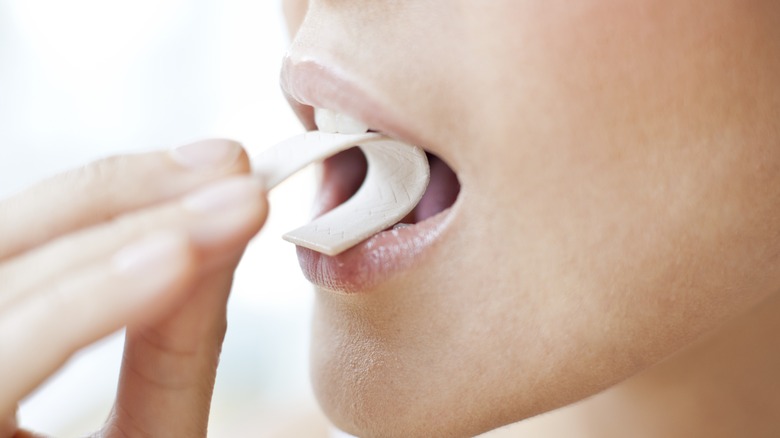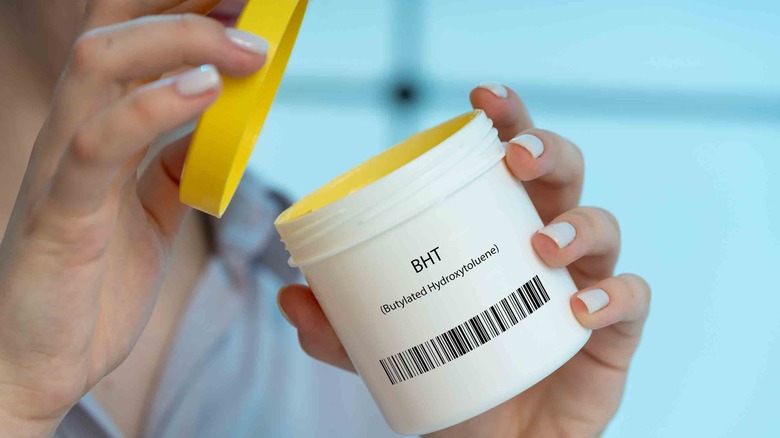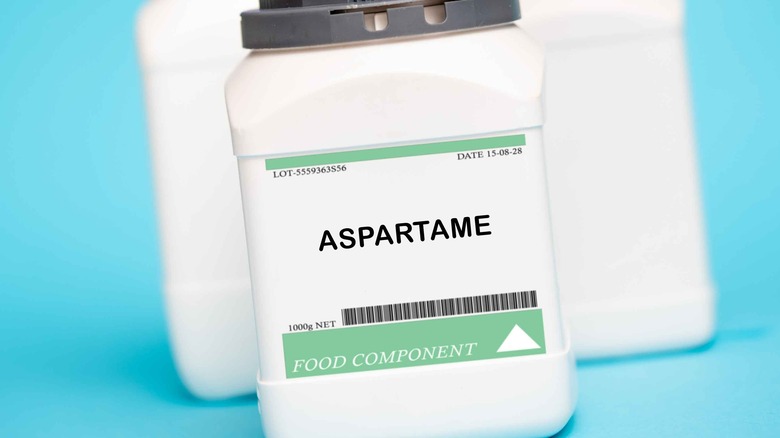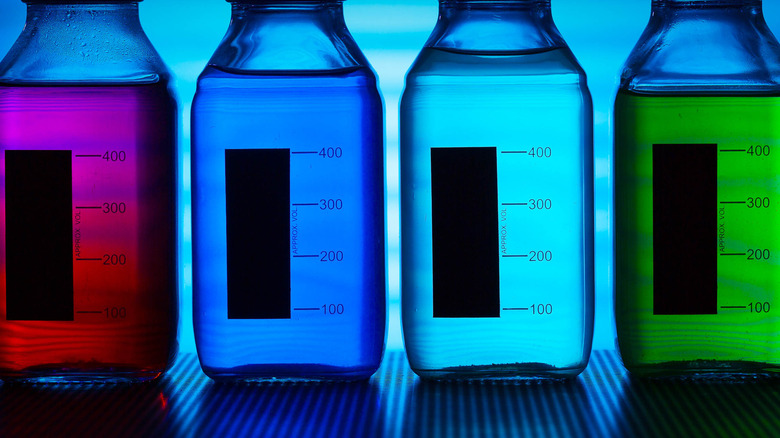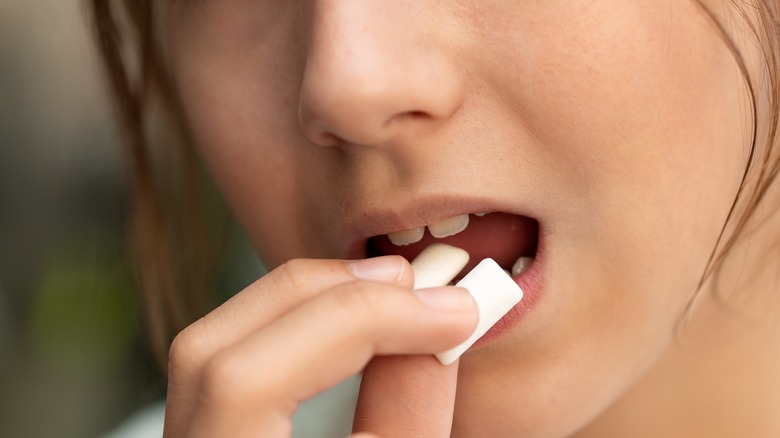What You're Really Sucking On When Chewing A Stick Of Gum
While the nutritional value of various chewing gums will vary, the U.S. Department of Agriculture states that one stick of regular gum has around 11 calories, 3 grams of carbohydrates, and 2 grams of sugar. A stick of sugar-free gum has a little over 5 calories, just under 2 grams of carbohydrates, and 0 grams of sugar. There are only negligible amounts of vitamins and minerals in either of these.
The gum base is what makes chewing gum chewable, according to the American Chemical Society. While its formula is usually kept secret by the manufacturer, there are three particular ingredients that gum bases are generally made of: resin, wax, and elastomer. The resin is the main part of the gum, the wax is there to make the gum softer, and the elastomer makes the gum more flexible.
However, chewing gums also have certain ingredients that are more controversial, such as butylated hydroxytoluene (BHT), aspartame, and artificial food dyes and colorings. In an exclusive interview with Health Digest, Lena Bakovic, MS, RDN, CNSC — a Registered Dietitian Nutritionist with Top Nutrition Coaching who specializes in gut health, chronic disease, weight management, intuitive eating, oncology, and general health and wellness — broke down these concerns and explained whether chewing gum is safe for consumption.
Butylated hydroxytoluene (BHT)
Butylated hydroxytoluene (BHT) is sometimes added to chewing gum to extend its shelf life, according to Bakovic. "Some animal studies have shown that very high doses of BHT can be carcinogenic," she added. "In humans, scientific research has not been sufficient nor extensive in demonstrating comparable effects to that with animals."
BHT is currently deemed by the U.S. Food & Drug Administration (FDA) to be generally recognized as safe. However, as Bakovic points out, it is only approved to be used in very small amounts. Per a 2021 study in the Journal of Undergraduate Chemistry Research which tested chewing gum samples for BHT, all of the samples tested below the FDA's limit of 1,000 micrograms per gram. They estimated that children of all ages from toddlers and up were not at any serious risk of overconsuming BHT with moderate consumption of gum.
Aspartame
Aspartame is an artificial sweetener that is commonly found in chewing gum as well as other sugar-free food products. "In human studies, aspartame has been correlated with obesity and headaches," said Bakovic. "Animal studies, however, have shown that aspartame is a carcinogen."
Most recently, a working group met at the International Agency for Research on Cancer (IARC) in June 2023. After examining the available research, they found an increased risk of cancers, but the evidence was too inconsistent to justify recategorizing aspartame to the World Health Organization's highest risk category. Instead, they classified it as possibly carcinogenic (via The Lancet Oncology).
However, the Joint FAO/WHO Expert Committee on Food Additives (JECFA) determined that the evidence was not convincing enough to alter their current set of recommendations for aspartame consumption (via World Health Organization).
In response to IARC's decision, the FDA said, "Aspartame is one of the most studied food additives in the human food supply." They say it is safe provided it is manufactured and used in the approved way.
Bakovic noted that many people are now aware of this potential connection between aspartame and cancer so they tend to avoid it completely. "Companies, in return, are now generally adding in other versions of artificial sweeteners as opposed to using aspartame," she said.
Artificial food dyes/colorings
"Children, in particular, appear to be more sensitive to these dyes, which may include Blue 1, Red Dye 40, and Yellow 5," Bakovic said. "The effects on children have been studied and observed mainly involving attention span and/or hyperactivity."
Additionally, it may be that lower consumption limits need to be considered. According to a 2021 report from the California Environmental Protection Agency's Office of Environmental Health Hazard Assessment (OEHHA), the FDA's Accepted Daily Intake (ADI) levels for these substances may not be low enough to protect children, especially those from lower-income families with limited access to healthier foods. They state that the current ADIs are based on older studies that were not designed to detect the behavioral effects we are now seeing.
However, they remain FDA-approved for use in the U.S., Bakovic said. "[P]arents may want to pay close attention to how their children respond to the ingestion of gum and other products which contain these dyes, as some children are definitely more sensitive than others."
Overall, chewing gum seems to safe
"In general, chewing gum appears to be safe for consumption," added Bakovic. "However, some individuals may experience headaches and jaw pain as the main potential side effects, especially if gum is consumed in large quantities."
Austin Oral Surgery writes that constant gum chewing can lead to the development of temporomandibular joint dysfunction (TMD). More often, though, it simply makes an existing condition worse. If you believe you have this condition, they suggest resting, using muscle relaxers, eating a soft diet, and getting physical therapy under the management of a dentist and physical therapist. You should stop chewing gum and allow your muscles to relax. If this isn't enough, then you should visit a dentist who specializes in treating TMD.
Bakovic did advise caution, however, when it comes to children. There is a potential for artificial food colorings and dyes in gums to affect hyperactivity and attention span, she said. If a child appears to be reacting to artificial food colorings and dyes, it may be wise to investigate chewing gum alternatives that do not contain them.
Healthier chewing gum alternatives
While ingredients like BHT, aspartame, and artificial food dyes and colors are considered to be safe for consumption in the amounts that are commonly found in chewing gum, if you would prefer to avoid them altogether there are several products on the market that do not contain them. These brands include Simply Gum, Pur, Spry, Xylichew, The Humble Co., Project 7, Chicza, and Glee.
Be aware, however, that some brands of chewing gum, such as Simply Gum, Chicza, and Glee, do contain cane sugar, which may contribute to cavities. Boston Dental Group states that xylitol is a better alternative for your teeth. Xylitol is a type of sugar alcohol derived from plants, including birch trees, beech trees, rice, oats, wheat, cotton husks, and corncobs. While xylitol tastes sweet like sugar, the bacteria that live in your mouth aren't able to consume it as a food source. In fact, they say, it can even slow bacterial growth and help to prevent cavities. They further point out that the act of chewing gum helps clear away bacteria and keeps your teeth cleaner.
